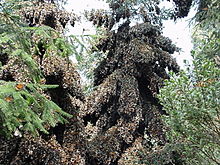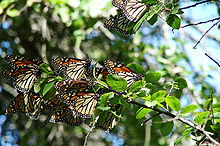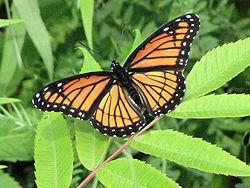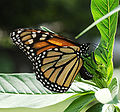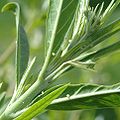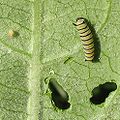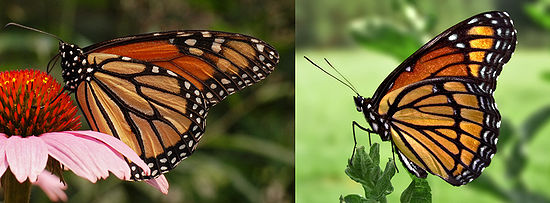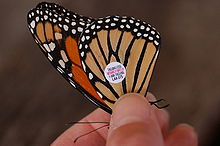- Monarch (butterfly)
-
Monarch 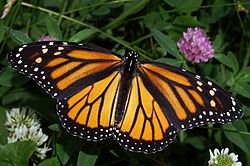
Female 
Male Conservation status Scientific classification Kingdom: Animalia Phylum: Arthropoda Class: Insecta Order: Lepidoptera Family: Nymphalidae Tribe: Danaini Genus: Danaus
Kluk, 1802Species: D. plexippus Binomial name Danaus plexippus
(Linnaeus, 1758)
Synonyms Danaus archippus (Fabricius, 1793)[1]
Danaus menippe (Hübner, 1816)[2]The Monarch butterfly (Danaus plexippus) is a milkweed butterfly (subfamily Danainae), in the family Nymphalidae. It is perhaps the best known of all North American butterflies. Since the 19th century, it has been found in New Zealand, and in Australia since 1871 where it is called the Wanderer.[3][4][5] In Europe it is resident in the Canary Islands, the Azores, and Madeira, and is found as an occasional migrant in Western Europe and a rare migrant in the United Kingdom where it is called the Milkweed [1]. Its wings feature an easily recognizable orange and black pattern, with a wingspan of 8.9–10.2 centimetres (3½–4 in).[6] (The Viceroy butterfly has a similar size, color, and pattern, but can be distinguished by an extra black stripe across the hind wing.) Female Monarchs have darker veins on their wings, and the males have a spot called the "androconium" in the center of each hind wing[7] from which pheromones are released. Males are also slightly larger.
The Monarch is famous for its southward migration and northward return in summer from Canada to Mexico and Baja California which spans the life of three to four generations of the butterfly.
Contents
Taxonomy
The common name “Monarch” was first published in 1874 by Samuel H. Scudder because “it is one of the largest of our butterflies, and rules a vast domain”[8]; however, the name may be in honour of King William III of England.[9] The Monarch was one of the many species originally described by Linnaeus in his Systema Naturae of 1758. It was first placed in the genus Papilio.[10] In 1780, Jan Krzysztof Kluk used the Monarch as the type species for a new genus; Danaus. Since Latin grammar requires that the specific epithet and gender names agree it is unclear if the genus Danaus is drawn from Danaus (Greek Δαναός), a mythical king of Egypt and great-grandson of Zeus or is a masculinised version of Danaë (Greek Δανάη), Danaus’s great-great-granddaughter. The species name, plexippus, refers to Plexippus, one of the 50 sons of Aegyptus, Danaus’ twin brother.[8][11] In Homeric Greek δαναος πληξιππος also means "a Greek who beats (= lashes, drives and urges on) horses", i.e. "Greek charioteer".
The Monarch is closely related to two very similar species which formed the Danaus (Danaus) subgenus before 2005. The first is the Jamaican monarch (D. cleophile) from Jamaica and Hispaniola. The second is the Southern Monarch (D. erippus), of South America south of the Amazon river. The Southern Monarch is almost indistinguishable from the Monarch as an adult, the pupae are somewhat different, and is often considered a subspecies of the Monarch proper. But analysis of morphological, mtDNA 12S rRNA, cytochrome c oxidase subunit I, nuclear DNA 18S rRNA and EF1 subunit α sequence data by Smith et al. (2005) indicates that it is better considered a distinct species. The separation of the Monarch and Southern Monarch is comparatively recent. In all likelihood, the ancestors of the Southern Monarch separated from the Monarch's population some 2 mya, at the end of the Pliocene. At the time sea levels were higher and the entire Amazonas lowland was a vast expanse of brackish swamp that offered hardly any butterfly habitat.[12]
Following the review of Smith et al. (2005), two sub-species of the Monarch are recognized:[12]
- Danaus p. plexippus, the nominate subspecies, described by Linnaeus in 1758. It is the migratory subspecies known from most of North America.
- Danaus p. megalippe, named in 1826 by Jacob Hübner. It is the non-migratory subspecies, and is found from Florida and Georgia southwards, throughout the Caribbean and Central America to the Amazon River. Three local forms were at first considered to be other subspecies, but are actually colour varieties of D. p. megalippe:
- D. p. m. forma leucogyne, named by Arthur G. Butler in 1884.
- D. p. m. forma portoricensis, named in 1941 by A.H. Clark.
- D. p. m. forma tobagi, also named in 1941 by A.H. Clark.
Description
The Monarch’s wingspan ranges from 8.9–10.2 cm (3½–4 in.).[6] The upper side of the wings is tawny-orange, the veins and margins are black, and in the margins are two series of small white spots. The fore wings also have a few orange spots near the tip. The underside is similar but the tip of the fore wing and hind wing are yellow-brown instead of tawny-orange and the white spots are larger.[13]
The male has a black patch of androconial scales responsible for dispersing pheromones on the hind wings, and the black veins on its wing are narrower than the female’s. The male is also slightly larger.[13]
A color variation has been observed in Australia, New Zealand, Indonesia and the United States as early as the late 19th century. Named nivosus by Lepidopterists, it is grayish white in all areas of the wings that are normally orange. Generally it is only about 1% or less of all monarchs, but has maintained populations as high as 10% on Oahu in Hawaii, possibly due to selective predation.[14]
Like all insects the Monarch has six legs, however it uses only four of its legs as it carries its two front legs against its body.[15]
The eggs are creamy white and later turn pale yellow. They are elongate and subconical, with approximately 23 longitudinal ridges and many fine traverse lines.[13] A single egg weighs about 0.46 milligrams (0.0071 gr), and measures about 1.2 millimetres (47 mils) high and 0.9 millimetres (35 mils) wide.[16][17]
The caterpillar is banded with yellow, black, and white stripes. The head is also striped with yellow and black. There are two pairs of black filaments, one pair on each end of the body. The caterpillar will reach a length of 5 cm (2 in).[18]
The chrysalis is blue-green with a band of black and gold on the end of the abdomen. There are other gold spots on the thorax, the wing bases, and the eyes.[19]
Range and distribution
In North America, the Monarch ranges from southern Canada to northern South America. It rarely strays to western Europe (rarely as far as Greece) from being transported by U. S. ships or by flying there if weather and wind conditions are right. It has also been found in Bermuda, Hawaii, the Solomons, New Caledonia, New Zealand, Australia, New Guinea, Ceylon, India, the Azores, and the Canary Islands.[19]
Migration
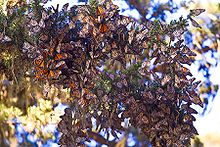 Monarch Butterflies in Pacific Grove, California
Monarch Butterflies in Pacific Grove, California
Monarchs are especially noted for their lengthy annual migration. In North America they make massive southward migrations starting in August until the first frost. A northward migration takes place in the spring. The monarch is the only butterfly that migrates both north and south as the birds do on a regular basis. But no single individual makes the entire round trip. Female monarchs deposit eggs for the next generation during these migrations.[20]
By the end of October, the population east of the Rocky Mountains migrates to the sanctuaries of the Mariposa Monarca Biosphere Reserve within the Trans-Mexican Volcanic Belt pine-oak forests in the Mexican states of Michoacán and México. The western population overwinters in various sites in central coastal and southern California, United States, notably in Pacific Grove and Santa Cruz.
The length of these journeys exceeds the normal lifespan of most monarchs, which is less than two months for butterflies born in early summer. The last generation of the summer enters into a non-reproductive phase known as diapause and may live seven months or more.[7] During diapause, butterflies fly to one of many overwintering sites. The generation that overwinters generally does not reproduce until it leaves the overwintering site sometime in February and March.
It is thought that the overwinter population of those east of the Rockies may reach as far north as Texas and Oklahoma during the spring migration. It is the second, third and fourth generations that return to their northern locations in the United States and Canada in the spring. How the species manages to return to the same overwintering spots over a gap of several generations is still a subject of research; the flight patterns appear to be inherited, based on a combination of the position of the sun in the sky[21] and a time-compensated Sun compass that depends upon a circadian clock that is based in their antennae.[22][23] New research has also shown that Monarch butterflies can use the earth's magnetic field for orientation. The antennae contain cryptochrome a photoreceptor protein that is sensitive to the violet-blue part of the spectrum. In the presence of violet or blue light it can function as a chemical compass, which tells the animal if it is aligned with the earths magnetic field, but it is unable to tell the difference between the magnetic North or South. The complete magnetical sense is present in a single antenna.[24][25]
Monarch butterflies are one of the few insects capable of making trans-Atlantic crossings. They are becoming more common in Bermuda due to increased usage of milkweed as an ornamental plant in flower gardens. Monarch butterflies born in Bermuda remain year round due to the island's mild climate. A few monarchs turn up in the far southwest of Great Britain in years when the wind conditions are right, and have been sighted as far east as Long Bennington. In Australia, Monarchs make limited migrations in cooler areas,[3] but the Blue Tiger butterfly is better known in Australia for its lengthy migration.[4] Monarchs can also be found in New Zealand. On the islands of Hawaii no migrations have been noted.
Monarch butterflies are poisonous or distasteful to birds and mammals because of the presence of cardiac glycosides that are contained in milkweed consumed by the larva. It is thought that the bright colors of larvae and adults function as warning colors. During hibernation monarch butterflies sometimes suffer losses because hungry birds pick through them looking for the butterflies with the least amount of poison, but in the process killing those that they reject.
A recent study examined wing colors of migrating monarchs using computer image analysis and found migrants had darker orange (reddish colored) wings than breeding monarchs.[26]
Habitat
Perhaps one of the most well-known examples of mimicry, the viceroy butterfly (top) appears very similar to the noxious tasting monarch butterfly (bottom). Although it was for a long time purported to be an example of Batesian mimicry, it has recently been discovered that the viceroy is actually more unpalatable than the monarch, making this a case of Müllerian mimicry.[27]The Monarch can be found in a wide range of habitats such as fields, meadows, prairie remnants, urban and suburban parks, gardens, and roadsides. It overwinters in conifer groves.[28][29]
Adult food sources
Adult Monarchs have been seen on a number of different nectar plants. A list of nectar-resources exploited by Monarch butterflies is as follows:
- Apocynum cannabinum - Indian Hemp
- Asclepias californica - California Milkweed
- Asclepias incarnata - Swamp Milkweed
- Asclepias syriaca - Common Milkweed
- Asclepias tuberosa - Butterfly Weed
- Aster sp. - asters
- Cirsium sp. - thistles
- Daucus carota - Wild Carrot
- Dipsacus sylvestris - Teasel
- Erigeron canadensis - Horseweed
- Eupatorium maculatum - Spotted Joe-Pye Weed
- Eupatorium perfoliatum - Common Boneset
- Hesperis matronalis - Dame's Rocket
- Medicago sativa - Alfalfa
- Solidago sp. - golden rods
- Syringa vulgaris - Lilac
- Trifolium pratense - Red Clover
- Vernonia altissima - Tall Ironweed[29]
Males will also take in moisture and minerals from damp soil and wet gravel, a behavior known as mud-puddling. The Monarch has also been noticed puddling at an oil stain on pavement.[29]
Reproduction
 Mature caterpillar feeding on swamp milkweed
Mature caterpillar feeding on swamp milkweed
The mating period for the overwinter population occurs in the spring, just prior to migration from the overwintering sites. The courtship is fairly simple and less dependent on chemical pheromones in comparison with other species in its genus.[30] Courtship is composed of two distinct stages, the aerial phase and the ground phase. During the aerial phase, the male pursues, nudges, and eventually takes down the female. Copulation occurs during the ground phase where the male and female remain attached for about 30 to 60 minutes.[31] A spermatophore is transferred from the male to the female. Along with sperm, the spermatophore is thought to provide the female with energy resources that aid her in carrying out reproduction and remigration. The overwinter population returns only as far north as they need to go to find the early milkweed growth; in the case of the eastern butterflies that is commonly southern Texas. The life cycle of a monarch includes a change of form called complete metamorphosis. The monarch goes through four radically different stages:
- The eggs are laid by the females during spring and summer breeding months. The eggs are laid onto the leaves of milkweed plants.[32]
- The eggs hatch (after 4 days), revealing worm-like larvae, the caterpillars. The caterpillars consume their egg cases, then feed on milkweed, and sequester substances called cardenolides, a type of cardiac glycoside. During the caterpillar stage, monarchs store energy in the form of fat and nutrients to carry them through the non-feeding pupa stage. The caterpillar stage lasts around 2 weeks.
- In the pupa or chrysalis stage, the caterpillar spins a silk pad on a twig, leaf, etc., and hangs from this pad by its last pair of prolegs. It hangs upside down in the shape of a 'J', and then molts, leaving itself encased in an articulated green exoskeleton. At this point, hormonal changes occur, leading to the development of a butterfly (metamorphosis). The chrysalis darkens (the exoskeleton becomes transparent) a day before it emerges, and its orange and black wings can be seen.
- The mature butterfly emerges after about two pupal weeks and hangs from the split chrysalis for several hours until its wings are dry (often in the morning). Meanwhile fluids are pumped into the crinkled wings until they become full and stiff. Some of this orangey fluid (called meconium) drips from the wings. Finally (usually in the afternoon) the monarch spreads its wings, quivers them to be sure they are stiff, and then flies away, to feed on a variety of flowers, including milkweed flowers, red clover, and goldenrod.
Monarchs can live a life of two to eight weeks in a garden having their host Asclepias plants and sufficient flowers for nectar. This is especially true if the flower garden happens to be surrounded by native forest that seems to be lacking in flowers.[citation needed]
Pictorial lifecycle
-
Monarch butterfly laying eggs on Asclepias curassavica 'Silky Gold'.
-
An early instar monarch caterpillar
-
Adult monarch butterfly feeding on a Zinnia
-
Monarch butterflies in Iowa, USA
Host plants
Here is a list of host plants used by the Monarch caterpillar:
- Asclepias amplexicaulis - Clasping Milkweed
- Asclepias asperula - Antelope Horns
- Asclepias californica - California Milkweed
- Asclepias cordifolia - Heart-leaf Milkweed
- Asclepias curassavica - Scarlet Milkweed
- Asclepias curtissii - Curtiss' Milkweed
- Asclepias eriocarpa - Woollypod Milkweed
- Asclepias erosa - Desert Milkweed
- Asclepias exaltata - Poke Milkweed
- Asclepias fascicularis - Narrow-leaf Milkweed
- Asclepias humistrata - Sandhill Milkweed
- Asclepias incarnata - Swamp Milkweed
- Asclepias linaria - Pine-needle Milkweed
- Asclepias meadii - Mead's Milkweed
- Asclepias nivea - Caribbean Milkweed
- Asclepias physocarpa - Swan Plant
- Asclepias purpurascens - Purple Milkweed
- Asclepias speciosa - Showy Milkweed
- Asclepias subulata - Rush Milkweed
- Asclepias subverticillata - Horsetail Milkweed
- Asclepias syriaca - Common Milkweed
- Asclepias tuberosa - Butterfly Weed
- Asclepias verticillata - Whorled Milkweed
- Calotropis gigantea - Crown Flower
- Calotropis procera - Apple of Sodom
- Cynanchum laeva - Sand Vine
- Sarcostemma clausa - White Vine[18][19]
Defense against predators
 Chemical structure of oleandrin, one of the cardiac glycosides
Chemical structure of oleandrin, one of the cardiac glycosides
Monarchs are foul-tasting and poisonous due to the presence of cardenolide aglycones in their bodies, which the caterpillars ingest as they feed on milkweed.[30] Both forms advertise their unpalatability with bright colors and areas of high contrast on the skin or wings. This phenomenon is known as aposematism.
Monarchs also contain cardiac glycosides in their bodies from the Asclepias plants that the caterpillars eat. Overwintering Monarchs in Mexico are often preyed upon by Black-headed Grosbeaks which are immune to that toxin. Other birds such as orioles and jays have learned to eat only the thoracic muscles and abdominal contents because these contain less poison than the rest of the body.[19] Some mice are also able to withstand large doses of the poison. Over time, overwintering adults become less poisonous, thus making them more vulnerable to predators. In Mexico, about 14% of the overwintering Monarchs are eaten by birds and mice.[28]
Monarchs share this defense with the similar-appearing viceroy butterfly, in an example of Müllerian mimicry. (Viceroys were at one time believed to be Batesian mimics of monarchs.)[27]
Relationship with humans
The monarch is the state insect of Alabama,[33] Idaho,[34] Illinois,[35] Minnesota,[36] Texas,[37] and the state butterfly of Vermont[38] and West Virginia.[39] It was nominated in 1990 as the national insect of the United States of America, along with the honeybee (Apis mellifera),[40] but the legislation did not pass.[41]
Many people like to attract monarchs by growing a butterfly garden with a specific milkweed species. Others enjoy raising them for pleasure or for educational purposes. For migrating flocks, sanctuaries have been created at favorite wintering locations,[42] and these migrations can generate significant tourism revenue.
Many schools also enjoy growing, and attending to monarch butterflies, starting with the caterpillar form. When the butterflies reach adulthood they are then released into the wild.[43]
Some organizations, such as the Cape May Bird Observatory, have monarch identification tagging programs. Plastic stickers are placed on the wing of the insect with identification information. Tracking information is used to study the migration patterns of monarchs, including how far and where they fly.[44]
The main villain on The Venture Bros. (a cartoon on the Adult Swim block of Cartoon Network) takes his name, costume and overall lifestyle from monarch butterflies.
Threats
Recent illegal deforestation of the monarch's overwintering grounds have led to a drastic reduction in the butterfly's population. Efforts to classify it as a protected species and to restore its habitat are under way.
Predators
Although monarchs feed on milkweed, variations in the quantity of cardiac glycosides exist between species, individuals and even parts of the host plant. The levels of toxins in adult monarchs reflect the levels in their host plants. This means some monarchs are not foul-tasting but are Batesian or auto-mimics. Some species of predators have learned to measure the toxins by taste and reject butterflies with high cardiac glycosides contents, eating only the ones with low cardiac glycosides contents. In the butterfly, the cardiac glycosides are concentrated in the abdomen and wings. Some species of predators differentiate these parts and consume only the most palatable ones.[45] Bird predators include Brown Thrashers, Grackles, Robins, Cardinals, Sparrows, Scrub Jays and Pinyon Jays.[45]
In North America, eggs and first instar larvae of the monarch are eaten by larvae and adults of the introduced Asian lady beetle (Harmonia axyridis).[46]
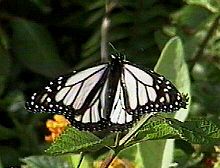 White morph of the monarch in Hawaii
White morph of the monarch in Hawaii
On Oahu, a white morph of the monarch has emerged. This is because of the introduction, in 1965 and 1966, of two bulbul species, Pycnonotus cafer and Pycnonotus jocosus. They are now the most common insectivore birds, and probably the only ones preying on insects as big as the monarch. Monarchs in Hawaii are known to have low cardiac glycoside levels, but the birds may also be tolerant for the chemical. The two species hunt the larvae and some pupae from the branches and underside of leaves in milkweed bushes. The bulbuls also eat resting and ovipositing adults, but rarely flying ones. Because of its colour the white morph has a higher survival rate than the orange one. This is either because of apostatic selection (i.e. the birds have learned the orange monarchs can be eaten), because of camouflage (the white morph matches the white pubescence of milkweed or the patches of light shining through foliage), or because the white morph does not fit the bird's search image of a typical monarch, and is thus avoided.[47]
Parasites
Parasites include the tachinid flies Sturmia convergens[48] and Lesperia archippivora. Lesperia-parasitized larvae complete their moult, suspend, but die before pupation. At that time one white maggot comes out of the larvae, suspended by a silken thread. The maggot then forms a brown pupa on the ground.[49]
The bacteria Micrococcus flacidifex danai also infects the larvae and causes “black death”. As usual, just before pupation the larvae migrate to a horizontal surface. They die a few hours later, attached only by one pair of prolegs, thorax and abdomen hanging limp. The body turns black shortly after. The bacteria Pseudomonas aeruginosa has no invasive powers, but causes secondary infections in weakened insects. It is a common cause of death in laboratory reared insects.[49]
The protozoan Ophryocystis elektroscirrha is another parasite of the monarch. It infects the subcutaneous tissues and propagates by spores formed during the pupal stage. The spores are found over all of the body of infected butterflies, with the greatest number on the abdomen. These spores are passed, from female to caterpillar, when spores rub off during egg-laying and are then ingested by caterpillars. Severely infected individuals are weak, unable to expand their wings, or unable to eclose, and have a shortened lifespan but probably occur at low frequencies in nature. This is not the case in laboratory or commercial rearing, where after a few generations all individuals can be infected.[50]
Confusion of host plants
A problem in North America is the black swallow-wort plant. Monarchs lay their eggs on these plants since they produce stimuli similar to milkweed. Once the eggs hatch, the caterpillars are poisoned by the toxicity of this invasive plant.
Genetically modified crops
The Monarch formed the subject of a controversial paper in Nature that suggested that pollen from genetically modified maize could blow onto the butterfly's favored food plant, Asclepias (milkweed), increasing larval mortality.[51] However, it has been generally accepted by the scientific community that this has still not been proven.[52]
See also
- Mimicry
- Aposematism
- Lepidoptera migration
- List of butterflies of Great Britain
- Peninsula Point Light, Michigan
- Monarch Butterfly Biosphere Reserve
References
- ^ Committee On Generic Nomenclature, Royal Entomological Society of London; Of Entomology, British Museum (Natural History) Dept (2007-05-23) [1934]. The Generic Names of British Insects. Royal Entomological Society of London Committee on Generic Nomenclature, Committee on Generic Nomenclature. British Museum (Natural History). Dept. of Entomology. pp. 20. http://books.google.com/?id=hgo1AAAAMAAJ&dq=%22Papilio+archippus+Fab.%22. Retrieved 2008-06-04.
- ^ Scudder, Samuel H.; William M. Davis, Charles W. Woodworth, Leland O. Howard, Charles V. Riley, Samuel W. Williston (1989). The butterflies of the eastern United States and Canada with special reference to New England. The author. pp. 721. ISBN 0665263228. http://books.google.com/?id=MOXnYGtuxx0C&dq=The+butterflies+of+the+eastern+United+States+and+Canada+with+special&q=menippe. Retrieved 2008-06-04.
- ^ a b "Wanderer Butterfly". Australian Museum: nature culture discover. Australian Museum, Sydney, Australia. http://australianmuseum.net.au/Wanderer-Butterfly/. Retrieved 2010-07-15.
- ^ a b "Regal the monarch butterfly". Critters of Calamvale Creek. Robert Doolan. 2007. http://calamvalecreek.awardspace.com/regal.html. Retrieved 2010-07-15.
- ^ "Wanderer Butterfly". Online Learning Resources. School of Biological Sciences, The University of Sydney. http://bugs.bio.usyd.edu.au/learning/resources/Entomology/internalAnatomy/imagePages/wandererCaterpillar.html. Retrieved 2010-07-15.
- ^ a b Garber, Steven D. (1998). The Urban Naturalist. Courier Dover Publications. pp. 76–79. ISBN 0486403998. http://books.google.com/?id=3w_X0A_Kq0gC&pg=PA76&dq=Danaus+plexippus+wingspan. Retrieved 2008-05-26.
- ^ a b "Monarch, Danaus plexippus". http://www.dbc.uci.edu/~pjbryant/biodiv/lepidopt/danaidae/monarchm.htm. Retrieved 2008-08-27.
- ^ a b Guppy, Crispin S.; Jon H. Shepard (2001) [2001-03-15]. Butterflies of British Columbia. UBC press. pp. 352–354. ISBN 0774808098. http://books.google.com/?id=E-reg6vdutcC&pg=PA353&lpg=PA353&dq=Aegytus+Danaus+in+Greek+mythology+(Bird+et+al.+1995). Retrieved 2008-03-29.
- ^ Jean, Adams (1992). Insect Potpourri: Adventures in Entomology. CRC Press. pp. 28–29. ISBN 1877743097. http://books.google.com/?id=KcqQ1rPZyRoC&pg=PA28&dq=danaus+plexippus+wingspan. Retrieved 2008-05-21.
- ^ Linnaeus, Carolus (1758) (in Latin). Systema Naturae. Stockholm: Holmiae (Laurentii Salvii). pp. 471. OCLC 174638949. http://gdz.sub.uni-goettingen.de/no_cache/dms/load/img/?search=1&IDDOC=265138&pid=PPN362053006&page=471&zoomfactor=100&firstIDDOC=265101&lastIDDOC=265150&prevIDDOC=265137&nextIDDOC=265139&pageturn=475&. Retrieved 2008-02-04.
- ^ Pyle, Robert Michael (2001). Chasing Monarchs: Migrating with the Butterflies of Passage. Houghton Mifflin Books. pp. 148–149. ISBN 0618127437. http://books.google.com/?id=gO9eXQI0ZxQC&pg=PA148&dq=monarch+danaus+mythology+danae. Retrieved 2008-05-14.
- ^ a b Smith, David A.; Gugs Lushai and John A. Allen (June 2005). "A classification of Danaus butterflies (Lepidoptera: Nymphalidae) based upon data from morphology and DNA" (PDF). Zoological Journal of the Linnean Society 144 (2): 191–212. doi:10.1111/j.1096-3642.2005.00169.x. http://www.blackwell-synergy.com/action/showPdf?submitPDF=Full+Text+PDF+%28214+KB%29&doi=10.1111%2Fj.1096-3642.2005.00169.x. Retrieved 2008-05-19.
- ^ a b c Braby, Michael F. (2000). Butterflies of Australia: Their Identification, Biology and Distribution. CSIRO Publishing. pp. 597–599. ISBN 0643065911. http://books.google.com/?id=_GjN8R9V-nsC&pg=PA597&dq=Danaus+plexippus+wingspan. Retrieved 2008-05-26.
- ^ The White Monarch, Lawrence Gibbs and Orley R. Taylor, Department of Entomology, University of Kansas, June 1998
- ^ Darby, Gene (1958). What is a Butterfly. Chicago: Benefic Press. p. 10.
- ^ Oberhauser, Karen S.; Michelle J. Solensky (2004). The Monarch Butterfly: Biology and Conservation. Cornell University Press. pp. 3. ISBN 0801441889. http://books.google.com/?id=H5nRqhCGA4UC&pg=RA1-PA21&dq=monarch+egg+size. Retrieved 2008-06-03.
- ^ "Monarch Life Cycle". Biology. Monarch Watch. http://www.monarchwatch.org/biology/cycle1.htm. Retrieved 2008-06-06.
- ^ a b David L. Wagner (2005). Caterpillars of Eastern North America. Princeton University Press, Princeton, NJ. ISBN 0-691-12144-3
- ^ a b c d James A. Scott (1986). The Butterflies of North America. Stanford University Press, Stanford, CA. ISBN 0-8047-2013-4
- ^ Pyle, Robert Michael, "National Audubon Society Field Guide to North American Butterflies", p712-713, Alfred A. Knopf, New York, ISBN 0-394-51914-0
- ^ Gugliotta, Guy (2003): Butterflies Guided By Body Clocks, Sun Scientists Shine Light on Monarchs' Pilgrimage. Washington Post, May 23, 2003, page A03. Retrieved 2006-JAN-07.
- ^ Merlin, C; Gegear, RJ; Reppert, SM. (2009). "Antennal circadian clocks coordinate sun compass orientation in migratory monarch butterflies". Science 325 (5948): 1700–1704. doi:10.1126/science.1176221. PMC 2754321. PMID 19779201. http://www.pubmedcentral.nih.gov/articlerender.fcgi?tool=pmcentrez&artid=2754321.
- ^ Kyriacou, CP. (2009). "Unraveling Traveling". Science 325 (5948): 1629–1630. doi:10.1126/science.1178935. PMID 19779177.
- ^ Robert J. Gegear, Lauren E. Foley, Amy Casselman & Steven M. Reppert (2010). "Animal cryptochromes mediate magnetoreception by an unconventional photochemical mechanism" (PDF). Nature 463 (7282): 804–807. doi:10.1038/nature08719. PMC 2820607. PMID 20098414. http://reppertlab.org/media/files/publications_files/naturepaperfeb11_01.pdf.
- ^ Monarch butterflies make use of a chemical magnetic compass
- ^ Davis, A.K (2009). "Wing color of monarch butterflies (Danaus plexippus) in eastern North America across life stages: migrants are 'redder' than breeding and overwintering stages". Psyche 2009: 1–5. doi:10.1155/2009/705780. http://www.hindawi.com/journals/psyche/2009/705780.html. Retrieved 19 December 2010.
- ^ a b Ritland, D.; L. P. Brower (1991). "The viceroy butterfly is not a Batesian mimic". Nature 350 (6318): 497–498. doi:10.1038/350497a0. http://www.nature.com/nature/journal/v350/n6318/abs/350497a0.html. Retrieved 2008-02-23. "Viceroys are as unpalatable as monarchs, and significantly more unpalatable than queens from representative Florida populations."
- ^ a b Rick Cech and Guy Tudor (2005). Butterflies of the East Coast. Princeton University Press, Princeton, NJ. ISBN 0-691-09055-6
- ^ a b c David C. Iftner, John A. Shuey, and John C. Calhoun (1992). Butterflies and Skippers of Ohio. College of Biological Sciences and The Ohio State University. ISBN 0-86727-107-8
- ^ a b "ADW: Danaus plexippus: Information". http://animaldiversity.ummz.umich.edu/site/accounts/information/Danaus_plexippus.html. Retrieved 2008-08-27.
- ^ Emmel. Thomas C., "Florida's Fabulous Butterflies", p 44, World Publications, 1997, ISBN 0-911977-15-5
- ^ http://education.nationalgeographic.com/education/activity/monarch-butterfly-life-cycle-and-migration/
- ^ "Official Alabama Insect". Alabama Emblems, Symbols and Honors. Alabama Department of Archives & History. 2001-07-12. http://www.archives.state.al.us/emblems/st_insec.html. Retrieved 2007-03-19.
- ^ "Idaho Symbols, Insect: Monarch Butterfly". Idaho State Symbols, Emblems, and Mascots. SHG resources, state handbook & guide. http://www.shgresources.com/id/symbols/insect/. Retrieved 2008-03-26.
- ^ "State Symbol: Illinois Official Insect — Monarch Butterfly (Danaus plexippus)". [Illinois] State Symbols. Illinois State Museum. http://www.museum.state.il.us/exhibits/symbols/insect.html. Retrieved 2008-03-26.
- ^ "Minnesota State Symbols" (PDF). Minnesota House of Representatives. http://www.house.leg.state.mn.us/hinfo/govser/GOVSER2.pdf. Retrieved 2008-03-26.
- ^ "Texas State Symbols". The Texas State Library and Archives. http://www.tsl.state.tx.us/ref/abouttx/symbols.html. Retrieved 2008-03-26.
- ^ "(Vermont) State Butterfly". Vermont Department of Libraries. Archived from the original on 2008-05-18. http://web.archive.org/web/20080518004053/http://www.libraries.vermont.gov/www/html/emblems/butterfly.htm. Retrieved 2008-03-26.
- ^ "West Virginia Statistical Information, General State Information" (PDF). Official West Virginia Web Portal. Archived from the original on 2008-04-11. http://web.archive.org/web/20080411045927/http://www.wv.gov/govdirectory/statgeninfo.pdf. Retrieved 2008-03-26.
- ^ Wade, Nicholas (1990-06-01). "Choosing a National Bug". The New York Times. http://query.nytimes.com/gst/fullpage.html?res=9C0CE4D81439F932A35755C0A966958260. Retrieved 2008-03-26.
- ^ "Frequently Asked Questions on Entomology". Entomological Society of America. http://www.entsoc.org/resources/faq.htm#triv7. Retrieved 2008-03-26.
- ^ "Saving Butterflies: Insect Ecologist Spearheads Creation of Oases for Endangered Butterflies". ScienceDaily. 2005-01-01. http://www.sciencedaily.com/videos/2005/0810-saving_butterflies.htm. Retrieved 2008-05-27.
- ^ "Monarch Watch". The Kansas Biological Survey, Univ of Kansas. 2008-05-27. http://www.monarchwatch.org/. Retrieved 2008-05-27.
- ^ "Monarch Monitoring Project". Cap May Bird Observatory. 2008. http://www.birdcapemay.org/monarch.shtml. Retrieved 2008-12-05.
- ^ a b Barbosa, Pedro; Deborah Kay Letourneau (1988). "5". Novel Aspects of Insect-plant Interactions. Wiley-Interscience. pp. 29–31. ISBN 0471832766. http://books.google.com/?id=2fZbhllItE4C&pg=PA45&dq=monarch+predators+asclepias. Retrieved 2008-05-12.
- ^ Koch, R. L.; W. D. Hutchison, R. C. Venette and G. E. Heimpel (October 2003). "Susceptibility of immature monarch butterfly, Danaus plexippus (Lepidoptera: Nymphalidae: Danainae), to predation by Harmonia axyridis (Coleoptera: Coccinellidae)". Biological Control 28 (2): 265–270. doi:10.1016/S1049-9644(03)00102-6. http://www.sciencedirect.com/science?_ob=ArticleURL&_udi=B6WBP-48TKDRR-6&_user=1072191&_rdoc=1&_fmt=&_orig=search&_sort=d&view=c&_acct=C000051289&_version=1&_urlVersion=0&_userid=1072191&md5=fb8ace3d840cb24a87d5d7276ef7bb6c. Retrieved 2008-04-23.
- ^ Stimson, John; Mark Berman (1990). "Predator induced colour polymorphism in Danaus plexippus L. (Lepidoptera: Nymphalidae) in Hawaii". Heredity 65 (3): 401–406. doi:10.1038/hdy.1990.110. Lay summary.
- ^ Clarke, A.R.; M.P. Zalucki (2001). "Taeniogonalos raymenti Carmean & Kimsey (Hymenoptera: Trigonalidae) reared as a hyperparasite of Sturmia convergens (Weidemann) (Diptera: Tachinidae), a primary parasite of Danaus plexippus (L.) (Lepidoptera: Nymphalidae)". Pan-Pacific Entomologist 77 (?): 68–70.
- ^ a b Brewer, Jo; Gerard M. Thomas (1966). "Causes of death encountered during rearing of Danaus plexippus (Danaidae)" (PDF). Journal of the Lepidopterist's Society 20 (4): 235–238. http://research.yale.edu/peabody/jls/pdfs/1960s/1966/1966-20(4)235-Brewer.pdf. Retrieved 2008-04-13. Lay summary.
- ^ Leong, K. L. H.; M. A. Yoshimura, H. K. Kaya and H. Williams (1997). "Instar Susceptibility of the Monarch Butterfly (Danaus plexippus) to the Neogregarine Parasite, Ophryocystis elektroscirrha". Journal of Invertebrate Pathology 69 (1): 79–83. doi:10.1006/jipa.1996.4634. PMID 9028932. Lay summary.
- ^ John E. Losey, Linda S. Rayor & Maureen E. Carter (1999). "Transgenic pollen harms monarch larvae" (PDF). Nature 299 (6713): 214. doi:10.1038/20338. PMID 10353241. http://ag.arizona.edu/ento/courses/ento446_546/readings/Losey_1999.pdf.
- ^ Antony M. Shelton & Mark K. Sears (2001). "The Monarch butterfly controversy: scientific interpretations of a phenomenon" (PDF). The Plant Journal 27 (6): 483–488. doi:10.1046/j.1365-313X.2001.01118.x. PMID 11576433. http://oregonstate.edu/instruct/bi430-fs430/Documents-2004/9A-BT%20CROPS/Shelton-MonarchBT-PlantJ-2001.PDF.
External links
- [2] Raise Live Butterflies at http://www.butterflygardenhabitat.com
- Monarch website of The Reppert Laboratory at the University of Massachusetts Medical School.
- Photos and satellite images of monarch butterfly habitat, from USGS
- Australian Museum fact sheet on Monarch butterflies
- Monarch Migration Maps
- Monarch Watch of the University of Kansas Entomology Department
- USGS description of Monarch butterfly
- Monarch Health!
- More Than Monarchs
- Monarch butterfly on the UF / IFAS Featured Creatures Web site
- Monarch, Canadian Biodiversity Information Facility
- A route of Monarch Migration on GPSed.com
- PBS NOVA Documentary "The Incredible Journey of the Butterflies"
- Monarch egg eclosion
Categories:- IUCN Red List near threatened species
- Danaus
- Butterflies and moths of North America
- Butterflies of the United States
- Butterflies of Canada
- Fauna of Mexico
- Fauna of the California chaparral and woodlands
- Pollinators
- Plants and pollinators
- Animals described in 1758
Wikimedia Foundation. 2010.



